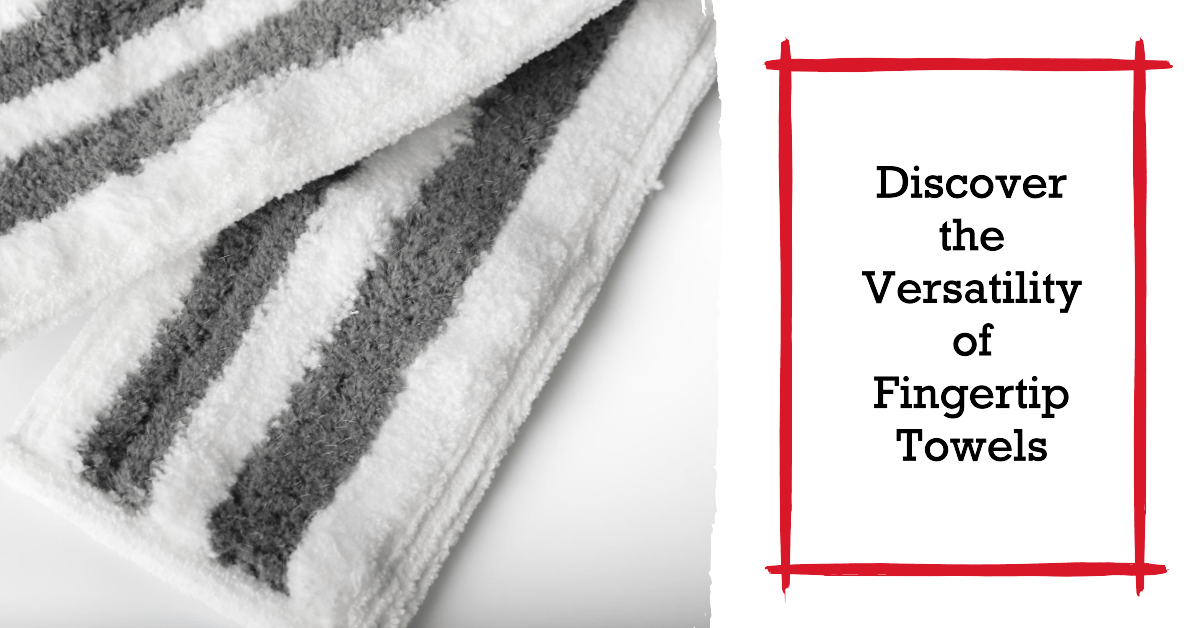In this article, we will cover everything you need to know about fingertip towels – what they are, their history, different materials and options available, how to care for them, creative uses, and more.
By the end of this article, you’ll be a fingertip towel expert – understanding their benefits, how to select the best ones for your needs.
Introduction
They are small, absorbent towels typically measuring 11 by 18 inches. They are designed to dry the hands or to quickly wipe up spills. They are smaller than hand towels but larger than washcloths. They are often used in bathrooms, kitchens, and powder rooms.
History
The origins of fingertip towels can be traced back to the practice of using finger bowls in upscale restaurants. During meals, guests would use finger bowls filled with warm water to rinse their fingertips during meals. To dry their hands after using the finger bowl, diners would use a small towel, which eventually became known as a fingertip towel.
The Industrial Revolution expanded towel manufacturing, making different sizes more accessible. As towel production increased, fingertip towels became more common in households. Nowadays, they are commonly found and used in many households and workplaces.

Benefits
- Decorative Touch: They come in various designs and colors, allowing homeowners to add a decorative touch to their bathrooms and kitchens.
- Compact Size: Easy to store and place anywhere needed. Takes up less space.
- Portability: Lightweight to carry around and move.
- Quick Drying: Small size means they dry faster.
- Versatility: Multiple uses beyond hand drying, such as wiping down counters, cleaning up spills.
Materials used in making
They are typically made of cotton or blends like modal and microfiber.
- Cotton is a natural fiber that is soft, absorbent, and durable. It is also relatively inexpensive.
- Modal is a fabric made from beechwood pulp. It is similar to cotton in many ways, but it is even softer and more absorbent. It is also more expensive than cotton.
- Microfiber is a synthetic fiber that is very absorbent and quick-drying. It is also very soft and durable.
Different Options Available in the Market
They come in a variety of weaves, each offering unique characteristics:
- Terry: Terry towels are the most common type, known for their looped pile that provides excellent absorbency.
- Velour: Velour towels have a smooth, velvety texture, offering a luxurious feel and absorbency.
- Waffle: Waffle towels have a textured pattern that creates air pockets, enhancing drying speed and adding visual interest.
- Jacquard: Jacquard towels feature intricate woven designs, offering a unique and decorative touch.

Choosing the Right Towel For Your Needs
Consider the following factors:
- Purpose: When choosing a towel, consider its primary purpose. If you need it to dry your hands and face, softness and absorbency are most important. If you need it for decoration, design and color may be more important.
- Material: Choose a material that suits your preferences, such as cotton for softness or microfiber for quick-drying.
- Weave: Choose a fabric that matches your style preferences. For instance, if you want a towel that absorbs water well, select terry cloth. If you want a towel that feels luxurious, choose velour.
- Color: Choose towels that complement your bathroom or kitchen décor.
Caring For Your Towels
Follow these care instructions:
- Wash before use. Wash new towels before using them to remove excess lint and any manufacturing residues.
- Avoid fabric softeners. Fabric softeners can make towels less absorbent.
- Use vinegar occasionally. Vinegar can help to remove odors and brighten colors. Add 1/2 cup of vinegar to your laundry wash cycle.
- Wash in hot water. Hot water will help to kill bacteria and remove dirt.
- Use non-chlorine bleach. Chlorine bleach can damage towels.
- Adequate Drying Time: Dry towels completely to prevent mildew growth.
Conclusion
In summary, they are more than just handy pieces of fabric for drying your hands. They are versatile, decorative, and come in a variety of materials to suit your needs. Proper care will keep them in excellent condition, ensuring they continue to serve you well. So, the next time you wonder, “What is a fingertip towel?” – you’ll have all the answers at your fingertips.
References
- American Textile History Museum: A History of Towels
- Towel Super Center: A Complete Guide to Fingertip Towels
Frequently Asked Questions
How do you display fingertip towels?
Fingertip towels can be displayed in various ways. Common methods include hanging them on towel racks, folding them neatly on countertops, or placing them in decorative baskets. Get creative and match the display style to your bathroom or kitchen decor.
What is the size difference between a hand towel and a fingertip towel?
A hand towel is typically 16 inches by 28 inches, while a fingertip towel is typically 11 inches by 18 inches. This means that a hand towel is about 1.5 times larger than a fingertip towel.
What is the difference between a washcloth and a fingertip towel?
A washcloth is a small, square towel that is typically used for washing the face or hands. It is usually made of terry cloth, a soft absorbent fabric. A fingertip towel is also a small towel, but it is longer and narrower than a washcloth. It is typically used for drying hands or for small tasks such as cleaning up spills.
What is another name for a fingertip towel?
Another name for a fingertip towel is a guest towel. This is because they are often used in guest bathrooms.
Learn More

